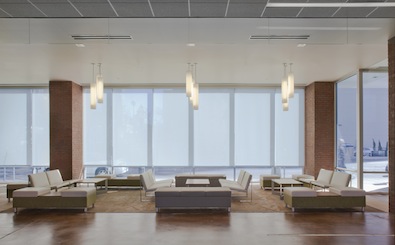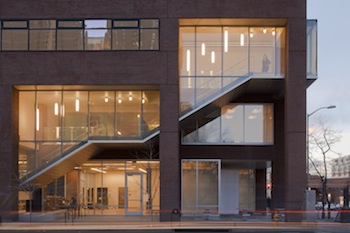Adapting New Business in an Old Building
 By Tania Salgado, AIA, LEED AP, Design Principal, RNL.
By Tania Salgado, AIA, LEED AP, Design Principal, RNL.
Salgado is a design principal with RNL, where she has planned, designed and led a variety of projects, including educational facilities, public buildings and private development. She is leading the design of the University of Colorado Denver’s Business School and Metropolitan State College Student Success Building. A mentor, lecturer and speaker, she recently presented “How to Design Community: A Thriving College, Campus and City” at the Society of College & University Planners Pacific Regional Conference.
Many prominent university programs view the creation of identity by means of a new building in an existing campus. One of Colorado’s most prestigious universities, the University of Colorado Denver’s Business School, is creating a premier urban university in downtown Denver.
By relocating, the Business School is taking advantage of what was already there: an existing building located in a prime downtown location that links education to the region’s businesses and is adjacent to fast-growth commercial, retail and restaurant areas. It is surrounded by significant recent and planned construction, consisting of more than 1,000 new hotel rooms, $1 billion worth of public projects and 600,000 square feet in commercial projects.
Through adaptive design, the new school will create a strong identity and act as a gateway from the city to a new education corridor in Denver. The completion of this multi-phased project will speak to a new business school that, in the midst of the existing structures of the surrounding business community, will give a fresh identity to a tired 1980s building that was once the heart and soul of Denver.
RNL built a transparent glass staircase into the existing structure. During the day, the transparent, understated outline of the stairs gives the student an elevated perspective of the city, and at night its glow serves as a warm lantern that can be seen from a distance. This feature has modernized a rigid structure and facilitates a ground-level connection that extends beyond the building and into the street and neighborhood.
CU Denver significantly expanded the Business School program into an existing building footprint. The plan called for a single facility that would house classrooms, faculty and administrative offices, and seminar and breakout spaces. In all, it would consolidate 15 locations currently spread around campus.
One of the school’s unique program involves a state-of-the art Center for Commodities: an on-hands classroom where students use live webcasts, touch-screen monitoring and simulated trading software that shows data on Colorado’s commodity-driven economy and energy companies. The program called for classrooms for 3,000 students who occupy the facility from dawn to dusk.
Meanwhile, students can interact on an existing rooftop that becomes an outdoor deck with sweeping mountain views. The ground-level café and courtyard will serve as an event center that will bring speakers, business people and students together.
 Above all, the renovated building serves as a positive example of sustainable adaptive reuse for the state and the region. What better resource is there than the reuse of an existing structure over building new?
Above all, the renovated building serves as a positive example of sustainable adaptive reuse for the state and the region. What better resource is there than the reuse of an existing structure over building new?
There is not one feature that makes this building sustainable, but rather several. These include new mechanical, plumbing and electrical systems that will drastically improve energy and water efficiency, the building envelope and glazing performance. Other features include proximity to light rail, commuter rail and the 16th Street free mall ride, and additions like recycling and building showers.
The existing building provided an early start for the opening of the Business School, but no adaptation project lacks challenges. Converting an office building into institutional space requires an understanding of the constraints provided by the existing conditions, and the ability to solve problems with creative solutions. Most alterations can be seen on the inside, where RNL rose above the limits of the existing structure, including close columns and tight ceilings, and found ways to accommodate tiered classrooms with raised floors. Wayfinding techniques, color, clear signage and complementing finishes further clarified the flow of the building.
With the first phase of the project completed, classes are under way. While the design is modern and innovative, the old structure is still easily visible. The new CU Denver Business School echoes the thriving business district: It is sustainable, approachable and relevant today, and remains adaptable for the future to come.
